
Interested in concealed carry pistols? Pocket pistols are the go-to option that can keep you safe.
But choosing the wrong gun could literally mean the difference between life and death.
Don’t worry, our collective 50+ years of firearm experience went into writing this article. Rest assured, you’re in good hands.
Here is our rundown of the best of the best pocket pistols for 2025.
Contents
Best Pocket Pistols
| Product | Type of Pistol | Caliber | Capacity (rounds) | Weight |
| Ruger LCP Max 380 ACP Pistol | Semi-auto | .380 ACP | 10 (+1) | 10.6oz |
| Sig Sauer P938 | Semi-auto | 9mm | 6 (+1) | 16oz |
| Beretta Tomcat | Semi-auto | .32 ACP | 7 | 14.5oz |
| Charter Arms Off Duty | Revolver | .38 Special | 5 | 12oz |
| Smith & Wesson Model 642 | Revolver | .38 Special | 5 | 14.6oz |
| Taurus 856CH Concealed Hammer | Revolver | .38 Special | 6 | 16oz |
| Ruger LCR 22 | Mouse | .22 Rimfire | 8 | 14.9oz |
| Mama Bear | Derringer | .357 & .38 S&W | 2 | 12.8oz |
Ruger LCP Max 380 ACP Pistol – Most Popular Pocket Pistol
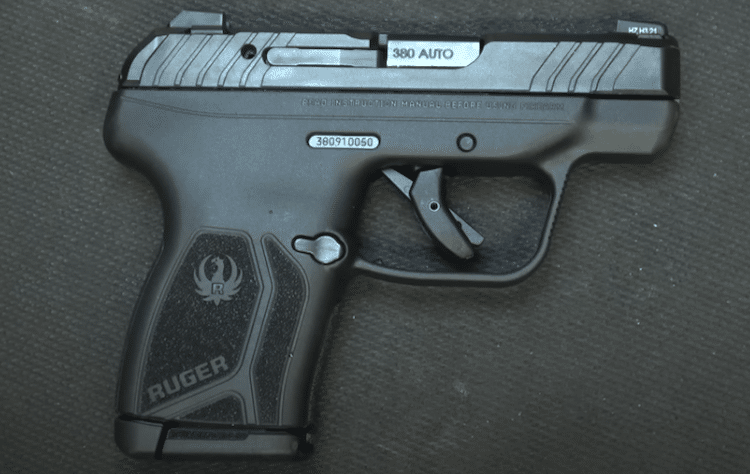
Pros
- Compact and easy to conceal
- Lightweight for comfortable carry
- High capacity for its size
- Easy-to-modify grip and sight
- Reduced snagging risk
Cons
- Grip might feel less secure
- Less powerful than a 9mm
- Double trigger not preferred by all
- Aesthetic design is fairly plain
The Ruger LCP line makes it into nearly every best pocket gun list for a reason. It deserves a spot. It’s easy to shoot. The .380, sometimes called a 9mm short, has a light recoil and provides enough punch to get the job done.
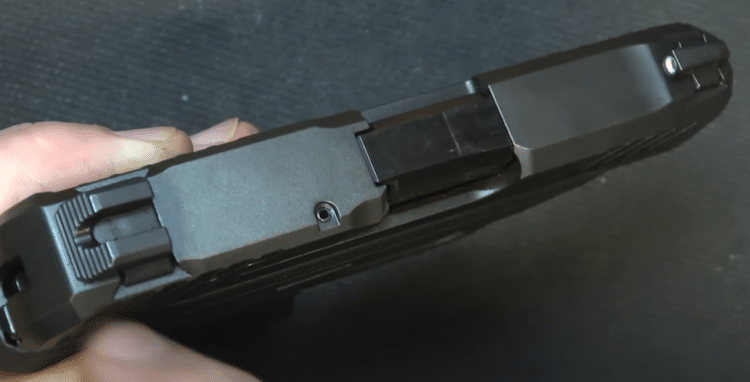
Its low profile is perfect for discretion, and its light weight makes it ideal for concealed carry. This is especially relevant if you’re planning on carrying all day as you’ll get less tired.
The .380 ACP is not as powerful as the 9mm, but it makes up for it in higher round capacity.
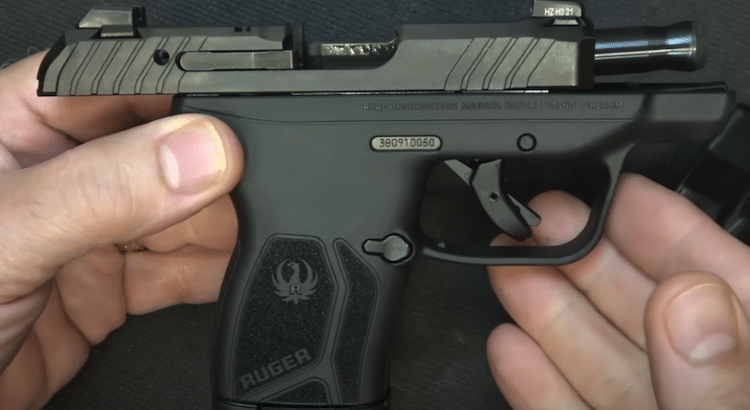
LCP stands for Light, Compact, Powerful. All the LCP lines are in .380 ACP.
This version stacks 10 rounds in the mag. You can get the handgun in a variety of grip colors, including pink, purple, and brown in the 6-round models. You can also buy a 12-round mag, so it’s super customizable to fit your style and intended purpose.
A big downside of using .380 for conceal carry is that the rounds cost more, despite being more compact. For a discussion on this see our post on why is .380 ammo so expensive.

Thanks to the polymer frame, the max tips the scales at 10.6oz. .380 ammo weighs less than .38 and 9mm, so you’re still coming out light. LCPs with a 6-round mag are even lighter at 9.6 ounces.
Same thing, customizable for every shooter.

This version has a 10-round mag, giving you an effective 11-shot capacity with one in the pipe. Personally, this is the one I’d recommend for most shooters – it still keeps the weight low but gives you a few more potentially critical shots.
For comparison, most pocket guns on this list can hold between 2-6 bullets.
I’ve used this pistol myself, so I can say with confidence that its recoil is manageable and its grip is comfortable for most people.
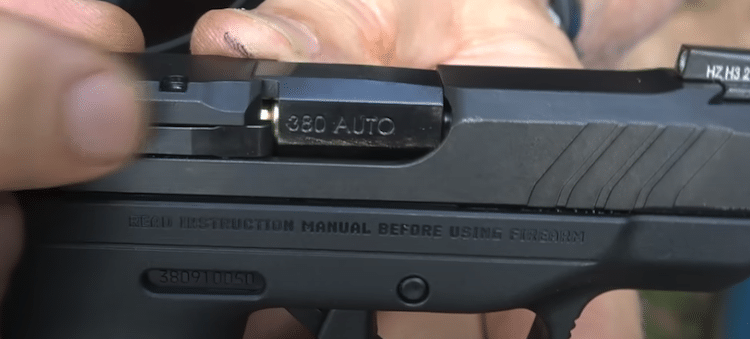
Its overall width is 0.81 inches, which is super low profile but is just enough for good handling. The height is 4.12 inches, and the length is 5.17 inches, which is incredible for a 10-round mag.
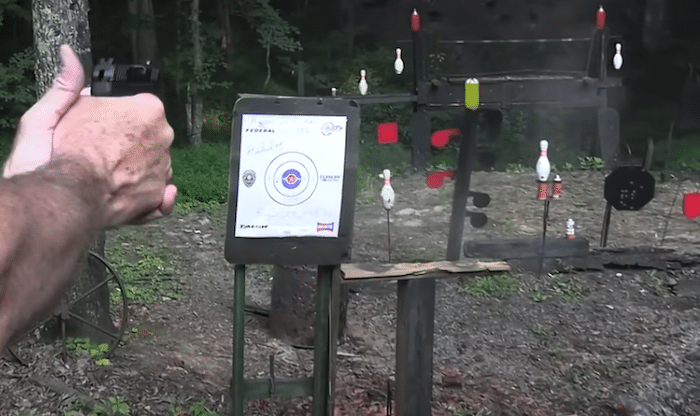
A drawback to this to me is the magazine. It does not have a lip sticking out on the bottom toward the front. I prefer that as it lets me grip the gun better. Some people don’t want that lip.
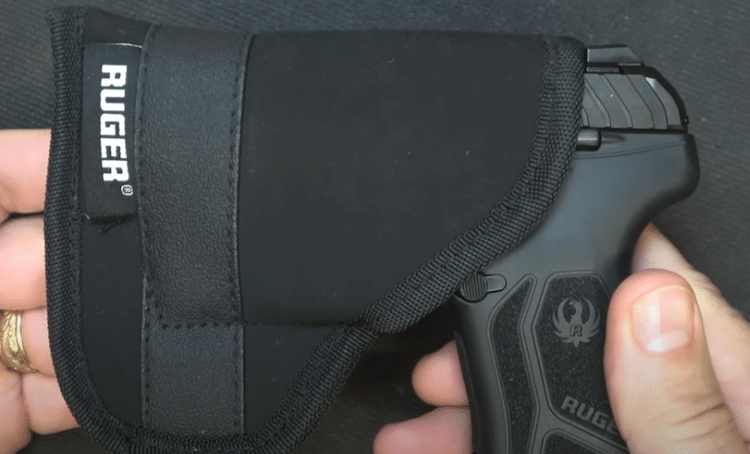
You can remove the front and rear sights to make this gun less likely to snag in a pocket draw situation.

I’m not a huge fan of the double trigger, but it works and provides an additional safety element.

Bottom line.
This is the best all-around pocket pistol on the market right now and is worth checking out.
***August, 2025 UPDATE***
The Ruger LCP is currently on sale with our certified online retailer until August 29, 2025. Make sure to use the link below to get the sale price:
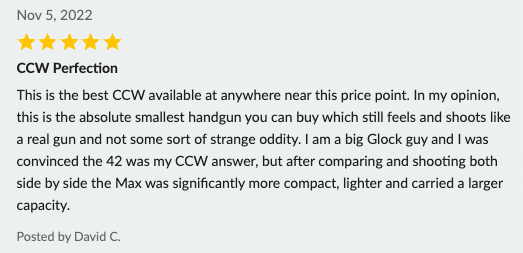
Sig Sauer P938 – Best Pocket 9mm Gun
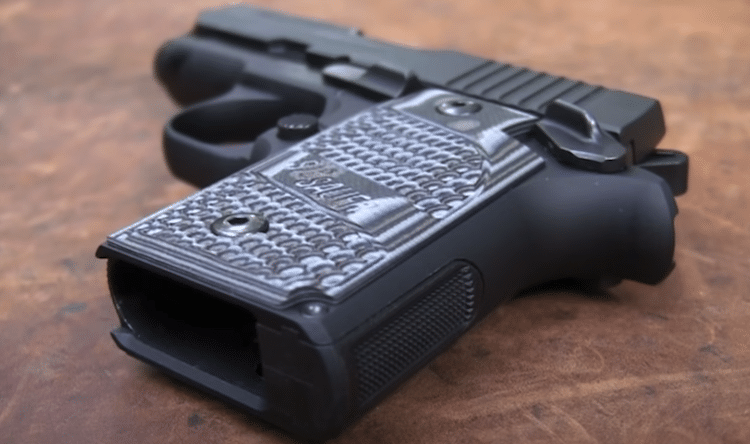
Pros
- High stopping power
- Compact for pocket carry
- Versatile ammunition capacity
- Customizable sights
Pros
- High stopping power
- Compact for pocket carry
- Versatile ammunition capacity
- Customizable sights
If you must have a pistol with max stopping power, at least 6 shots, and fits in your pocket, the Sig Sauer 938 is the go-to gun.
It’s a 9mm. It’s the best pocket pistol for those of you who want to prioritize firepower over weight.
But don’t worry. It’s still compact enough to fit in your pocket, perfect for a back pocket or waistband carry, particularly if you like using a holster.

You get 6 or 7 rounds in the mag, depending on the model, and one in the pipe. This gun is best suited for the back pocket if you carry without a holster.

If you carry with a holster, then a front pocket carry is OK. A lot of this is just personal preference.
It comes with Sig’s Night Sights. The front and rear sights are easy to remove, making drawing this from a pocket much easier.
Here’s a good picture of the sights that show what I mean:
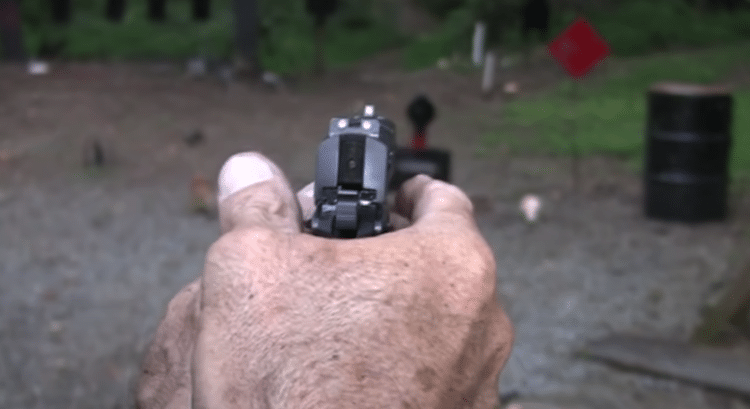
I’d keep them on because, in a low-light situation, they really pop. Wouldn’t want to have them off if you had to use it in a dark alley…
I’ve spent many hours on the range with the P938, so I can vouch for its power and accuracy. I even tested it at dusk to see how the night sights work.
Flawless is all I have to say.

After decades of using Sig Sauer’s products, I can say that they make great guns. The P938 is another example, and here they’ve found a perfect mix between power, size, and accuracy.
It weighs in at 16oz on the dot with the magazine in and, as you can see, at 15 ⅝oz with the magazine out. Not the lightest on the list, but for a 9mm, that’s incredible.

It has a 3-inch barrel which makes this 9mm provide more power than a snub nose and a lot more power than a .380.
But at the same time, you have more kick than a .380 and also bigger 9mms as a gun’s weight will absorb some recoil.
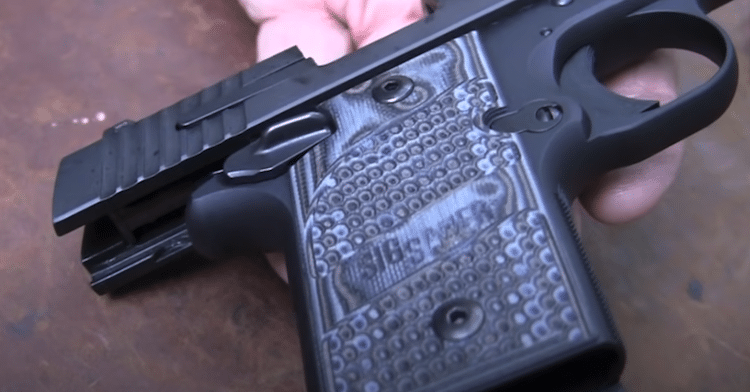
But no matter what, you’ll always have to compromise with a gun this size, and as far as I’m concerned, this gun checks all the boxes.
Beretta Tomcat – Best for Low Recoil

Pros
- Easy loading barrel
- Light recoil with the .32 ACP round
- Suppressor-ready threaded barrel
- Lightweight and compact profile
Pros
- Easy loading barrel
- Light recoil with the .32 ACP round
- Suppressor-ready threaded barrel
- Lightweight and compact profile
The Beretta Tomcat is a semi-auto that loads the first round by releasing the barrel and tipping it up. This makes it exceptionally easy to load, and is the best pocket pistol for someone with limited hand strength, as all you have to do is flip the level and it’s ready to go.
No cocking required on the gun itself.
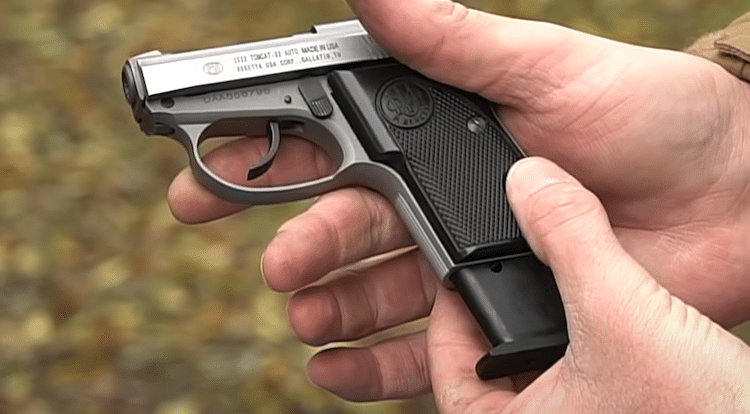
The .32 ACP is also a light recoiling round, which a person with weaker hands will greatly appreciate.
I’ve tried out the Tomcat myself a few times and found the easy load feature surprisingly nice to use.
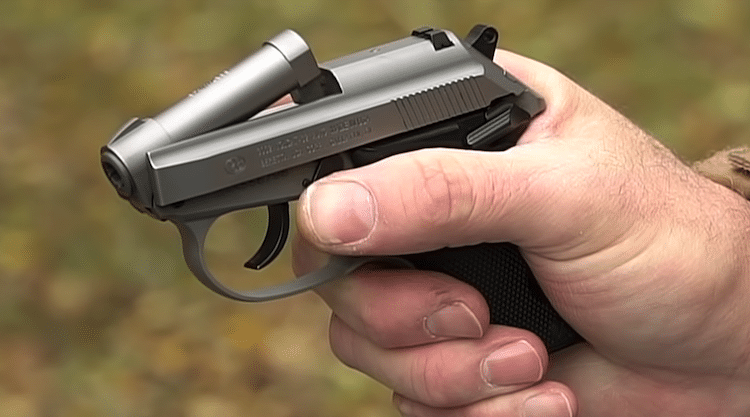
The light recoil of the .32 ACP means that it’s much less likely to fly out of your hands when you’re shooting. I found that it also didn’t tire my hands out as much on the range as it’s absorbing much less force.

The barrel is 2.4 inches long, and Beretta has recently started making these guns with a threaded barrel. If you decide to get a suppressor, you’ll make this gun so quiet you won’t need hearing protection to shoot it. Whisper-quiet.
However, a can stuck on the end eliminates the ability to pocket-carry this gun. Concealed carry with a suppressor is also extremely difficult.
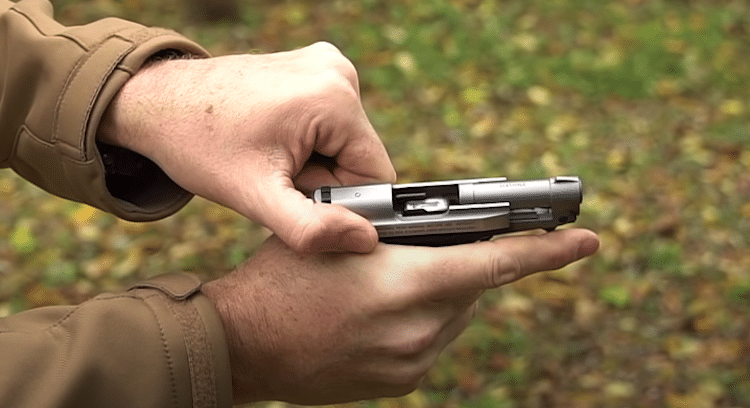
The gun weighs 14.5 ounces and has a 7-round mag. This, especially, is a gun you should carry with one in the chamber. Breaking the barrel to insert the first round in the pipe takes a moment or two, time you may not have in an emergency

The rear sight is very low profile and can be removed for an easier draw as there’s nothing to snag on your clothes.
Speaking of dimensions, this thing is tiny.

It’s 4.92 inches long, 3.7 inches tall, and 1.1 inches wide. It’s such a small gun, it literally fits in the palm of my hand.
The front sight is machined from the same piece of metal as the slide. Removing the front blade means filing, cutting, or grinding it off.

You can get it in different finishes and with wood or polymer grips. Customize however you’d prefer for your shooting or personal style.

Bottom line, this is a great pocket gun with really low recoil, perfect for those with weak or limited usability in their hands.
Charter Arms Off Duty – Best Hammerless Revolver

Pros
- Comfortable textured grip
- Extremely light under 12oz
- Very reliable
- Durable, well manufactured in the USA
Cons
- Lightweight causes higher recoil, especially with 38 Special +P rounds
- Front blade of sight can snag on clothes
- .38 caliber is a low caliber
The Charter Arms Off Duty holds the top spot for wheel guns.
This is my preferred snub nose wheel gun simply because the factory grips fit my hand better than the S&W below. You may prefer the S&W.
The CA has a more textured grip, meaning you can handle the recoil better due to the extra friction.
It also weighs 12 ounces, which is much lighter than most in the same category – for comparison, most other pocket pistols are around 14 to 16oz. That makes it more comfortable in your pocket.

While the .38 Special is not bad when it recoils, with +P loads, it has some kick but standard .38 ammo has less of a punch, so you can try both.

I practice with .38 Smith & Wesson ammo, which is just a .38 short. It has even less recoil but is not what I carry daily.
The gun has rubber grips, which absorbs some recoil and lets you keep a firm grip vs polymer or wood.

Grips are interchangeable, so all shooters can customize to their styles.
It’s also very compact for a revolver. The barrel is 2”, so it’ll fit nicely in your pocket.
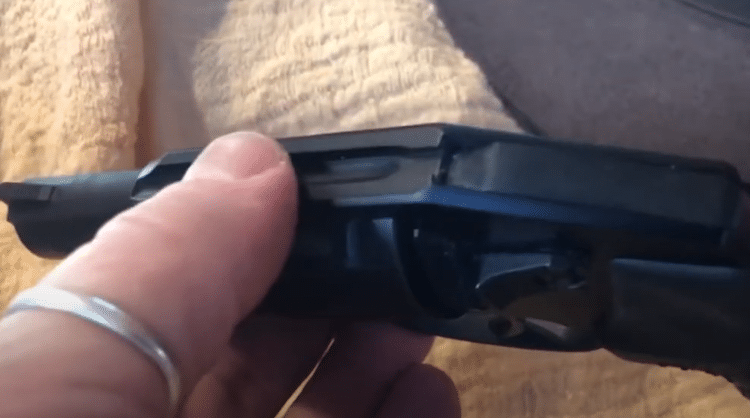
The gun’s groove in the strap and front blade are rudimentary sights – this can make accurate shots more difficult. But remember, sights are meant to be low profile for up close and personal shooting.
With practice, you can drill your target at 25 yards easily. I’m able to group at 3” at 15 yards consistently. That means the gun is very accurate.

That front blade, which is pretty high, is a problem if you don’t use a holster or carry with a fabric pocket holster.
The blade can snag your pocket if unholstered. In a fabric holster, it’ll tear through the cloth. So, you’ll need a leather or plastic holster.

Alternatively, get a gunsmith to file down the front blade. As long as you practice, you aren’t missing much.

It is double action only. Some like it, some don’t. The trigger is a long pull, but again, it’s a matter of preference.
The .38 has less punch than a good 9mm, which may bother some people.

Bottom line.
Mine has never let me down, and it has killed varmints up to the size of 100-pound hogs without issue. I’ve fired over 1000 of .38 Special and +P rounds.
It’s extremely reliable, even under heavy use. If you do your job, it will do its.
Smith & Wesson Model 642 Airweight – The Runner Up

Pros
- Industry leader for decades
- Stainless steel for rust resistance
- Available in various calibers
- Double-action for ease of use
- Rubber grip is very sticky
Cons
- Slightly heavy at 14.4oz
- Small grip, an issue for big hands
- Front sight could snag
- Long, heavy trigger pull
The Smith & Wesson Model 642 is No. 2 in the revolvers category.
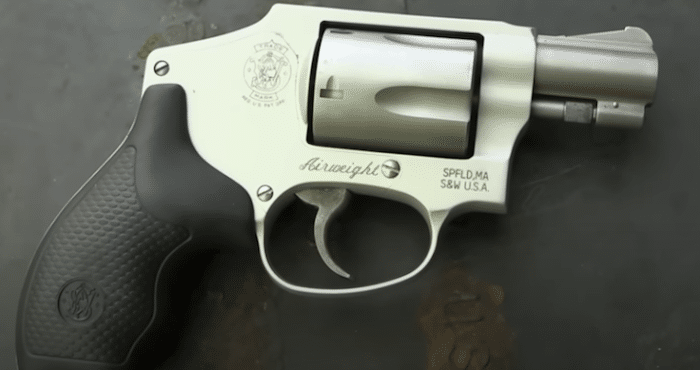
It comes in second place for a few reasons that may seem minor at first.
- It’s 14.4oz unloaded. That is heavier than the CA above.
- The grip does not fit my hand quite as well.
- That 90-degree angle on the front sight could hang up more than a straight ramp.
- It has a heavy trigger pull of nearly 11 lbs.
The 642 is stainless steel. You need not worry about this one rusting, so you might pass this thing down to your grandkids.

This gun comes in two other round choices; the Model 43 C is .22 LR and the 340 PD is .357 Mag. And I can say from experience that it handles them all like a champ.

Otherwise, there is no real difference between these two pocket pistols except the name and price.
This is a double-action only, making it much simpler to operate. So in a self-defense situation, you only need to worry about pointing and shooting.

I’ve shot the Model 642 in various conditions over the years. This ranges from the humid south to the dry desert, so I can vouch for its rust resistance.
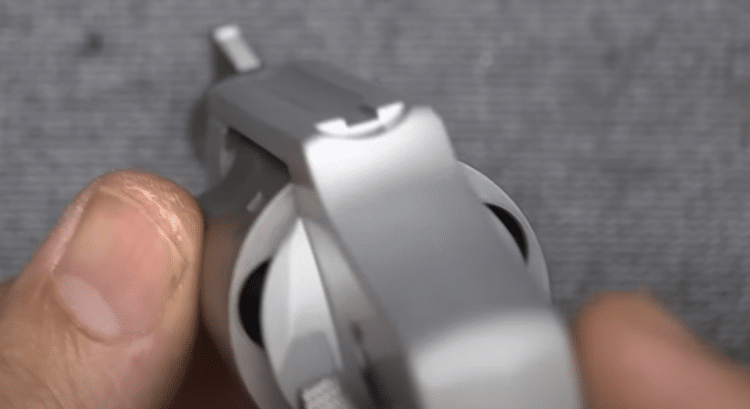
I’ve probably only put a few hundred rounds through it over the decades, but I have friends who claim to have shot thousands of rounds without a misfire.

Rest assured, it’s reliable, so it won’t fail you when you need it most.
Though it’s a “bit” heavy, it felt pretty steady in my hand. The weight also cuts down on the recoil as it literally absorbs the force, which is a plus.

The barrel is less than 2” long (1.88” to be exact), so it’s made for one thing.
Close shooting.
The gun’s length is 6.31 inches, 4.3 inches tall, and 1.3 inches wide, making the profile nice and compact, perfect for concealed carry. But the trigger pull is long due to the double action. I measured the pull at 10lb 7.1 ounces, which is HEAVY for a gun this size.
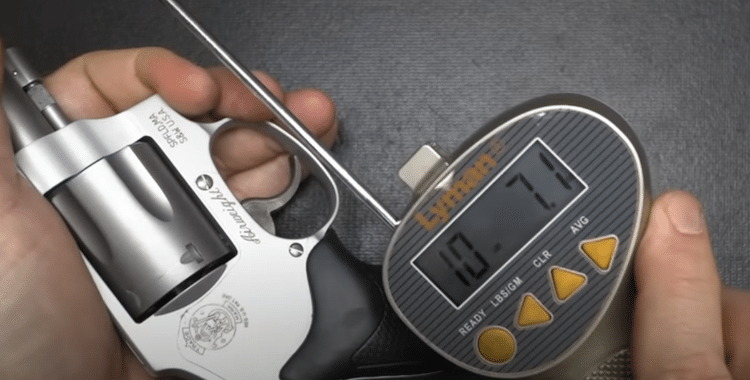
That said, the trigger was smooth as butter. However, for an inexperienced shooter or someone with small hands, that resistance could cause an issue. Just make sure you go to the range to get comfortable with it.
Taurus 856CH Concealed Hammer – Best 6 Shooter

Pros
- 6-round capacity
- Single and double action functionality
- Easy to clean
Cons
- Heavy gun frame
- 6th bullet adds even more weight
- Harder to conceal
- Complex single action operation
The Taurus 856CH is the best pocket pistol for those looking for a 6-round cylinder. It gives you one more shot than the revolvers above.
This leads to two issues you need to be aware of.
- At 16oz (unloaded), this is the heaviest of the pocket guns. Six rounds of average-weight ammo add another 3oz to what you’re packing. If you pocket carry in pants, that’s a LOT of weight.
- The 6-round cylinder means the gun is bigger across the cylinder. This both adds weight and makes the gun harder to conceal carry because it’s wider.
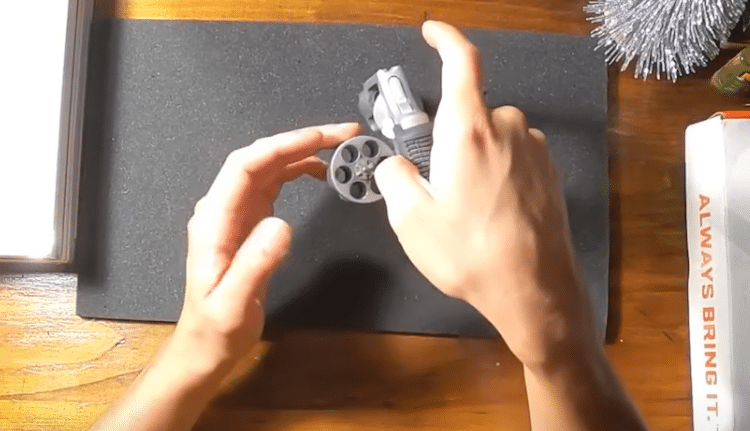
The length of the gun is 6.55”, height is 4.8”, and width is 1.41”. To compare, the S&W before was 1.3” wide, and the semi-autos above are less than an inch.

More width means that the gun “prints” more, meaning that others might know you’re carrying.
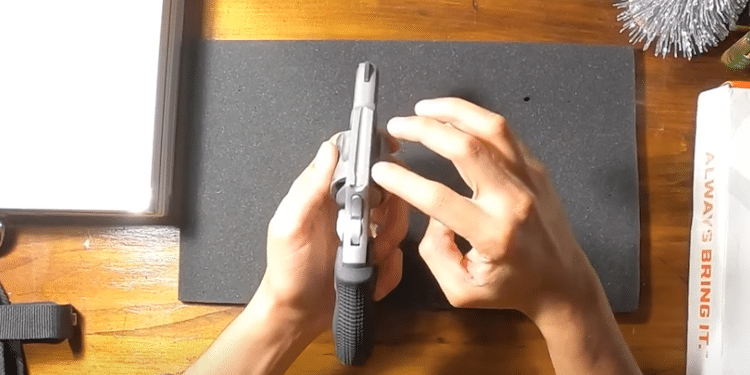
The 865CH has a spurless hammer. Taurus just took a snub 865 and machined the hammer spur off.
This means you can shoot it single action or double action, giving the shooter more flexibility and accuracy while shooting.
If you choose to shoot in single action, your off-hand has to grab the hammer as your trigger finger pulls the hammer back.

The exposed hammer has its plus – it makes it super easy to clean compared to true hammerless as you can retract the hammer and use a brush, which is worth considering.
But it can get complicated. If your hand slips, the gun might go off, and the hammer will, well, fire.
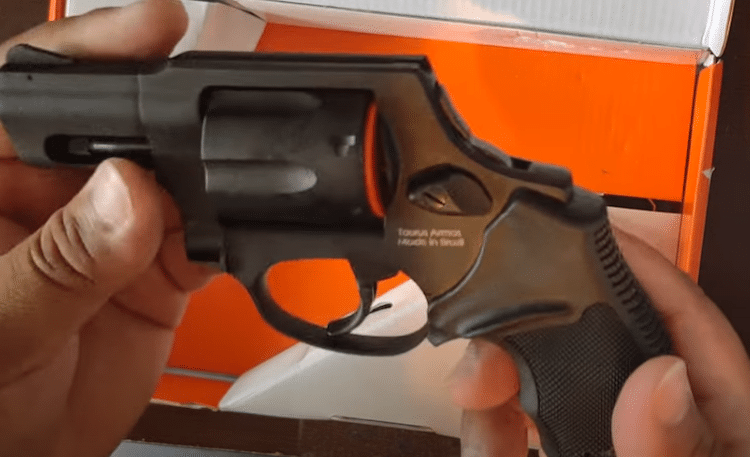
But in terms of pocket carry revolvers, the best thing about this one is the exposed hammer.
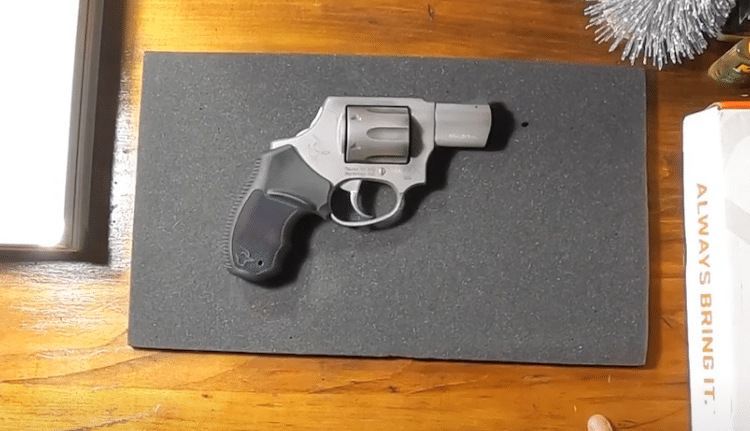
Bottom line for the Taurus is that it’s about trade-offs, another shot for more weight. Easy cleaning for more complex operations. That’s something every shooter needs to decide for themselves.
Ruger LCR 22 – Best Mouse Gun
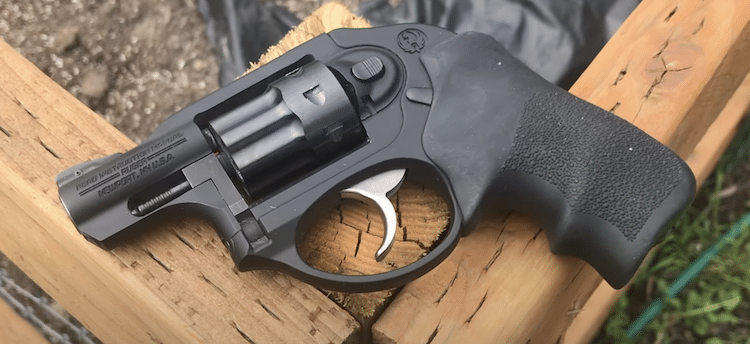
Pros
- 8-shot capacity
- Low recoil
- Lightweight with polymer parts
- Low profile for concealment
- Removable front sight
- Ideal for recoil-sensitive users
Cons
- .22 rimfire, low power round
- Double action only
- Heavy, long trigger
- Front sight can snag
The Ruger LCR 22 leads the list of best pocket pistol if you want a mouse gun.
You get 8 shots, twice that of a .38 or 9mm snubbie. Of course, it’s also a .22 rimfire, so you may need those extra shots.
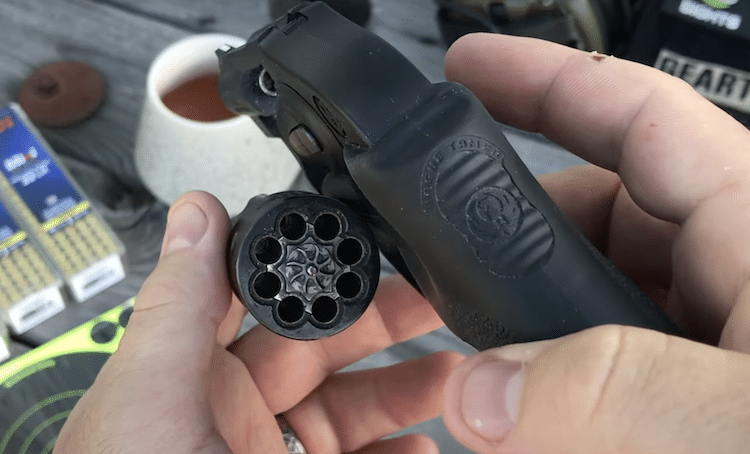
It’s hammerless, so it shoots in double action only. That makes operating it very simple, as you just need to point and shoot.
The cylinder is fluted to trim some weight. Still, it comes in at 14.9 ounces unloaded. That is on par with the other handguns on this list.

A good bit of the gun is also polymer for weight reduction. The rubber grips help tame the little recoil this gun has.
This gun still packs a punch, though – the short 1.87” barrel takes care of that. Rest assured, if you put the bullet in the right place, it will stop an attacker.
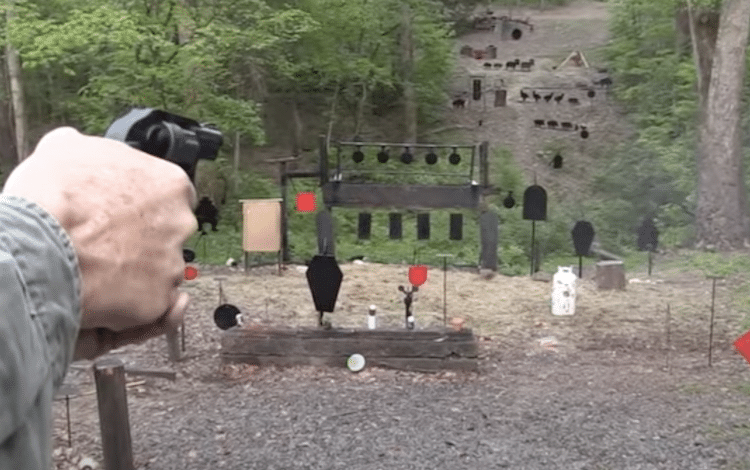
Talking dimensions, it has a length of 6.5”, a height of 4.5” and a width of 1.28”. That’s small enough to conceal in your pocket, belt, or boot, no problem.
The trigger pull?
I’m not going to sugarcoat it – it’s heavy. I tested mine just north of 15 lbs. Being a double action, it’s also quite long.
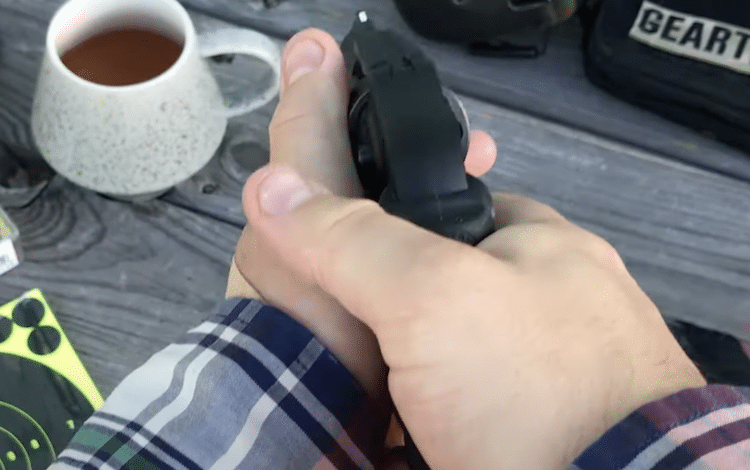
That’s the bad. The good is that the pull is smooth as silk, and the heavy trigger is manageable if you practice it.
But for those with a weak trigger finger or for inexperienced shooters, this might be a dealbreaker.
The front sight is pinned in place. You can remove it, which leaves the sight mount in place.
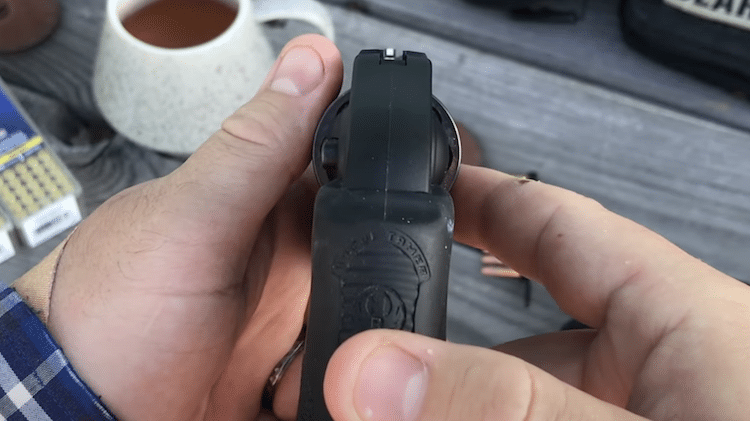
You can replace the front sight as well. The sight is excellent on this gun as the white mark pops, making quick pointing and shooting easier.
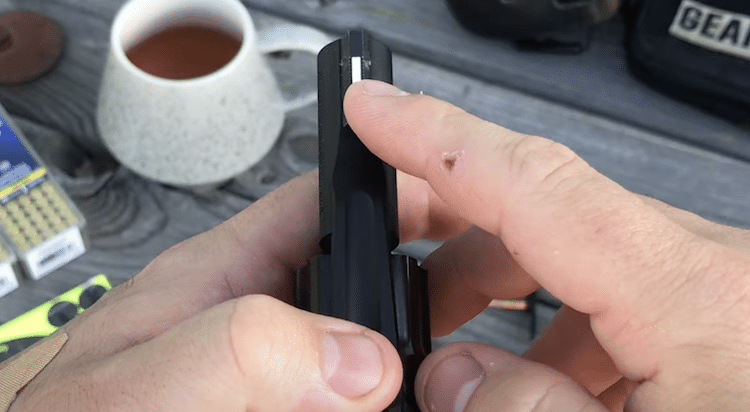
Perfect for a high-stress situation.
The ramped construction of that front blade is less likely to hang up than the front sight on some other revolvers, but it’s removable if you wish.
I did a 15-yard range test. The result?
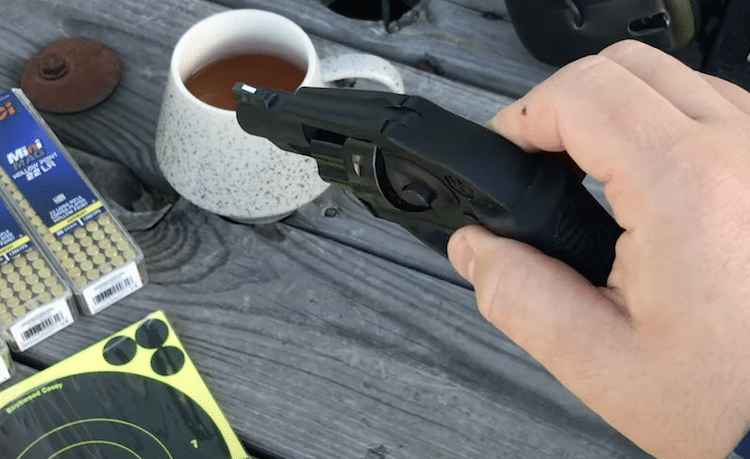
I had a tight grouping of around 3 inches.
That’s accuracy.
I squeezed out a few hundred rounds on this one at the range one day.
It’s a good gun for someone who is recoil shy. You do need a bit more hand strength to shoot this one vs some of the semi-autos above.
Remember this when choosing a pocket pistol: consider the recoil, weight, number of shots, trigger pull, and accuracy.

The price is also worth mentioning, as it isn’t the cheapest on the list, but what you’re getting is world-renowned Ruger quality and an extremely reliable firearm.
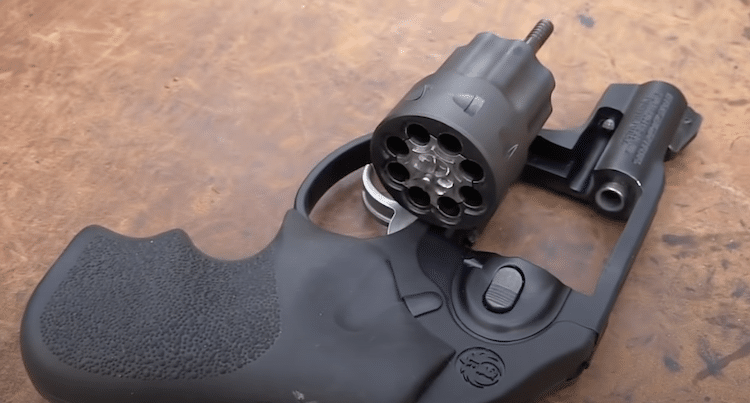
Where this one loses points is the stopping power due to the .22 LR round, which I argue it makes up for with the extra shots.
It’s not just about the specs. It’s what the specs mean to you as a shooter.
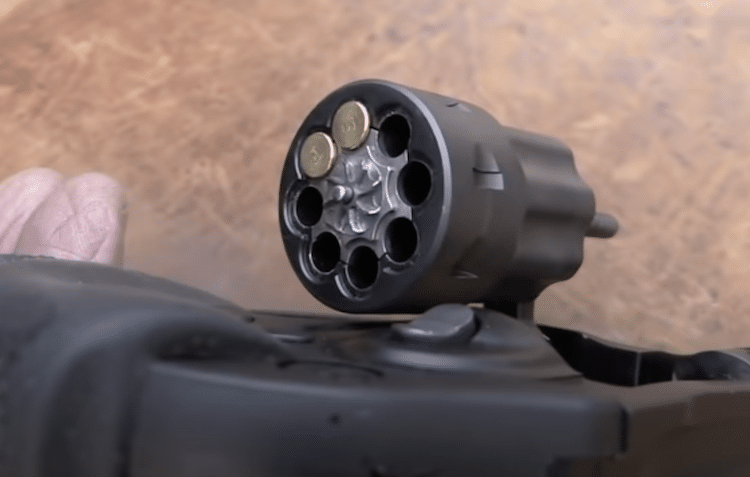
What sets this one apart is the 8-round capacity, low recoil, and great accuracy.
If I was to carry a .22 as a personal defense weapon, this would be my first choice.
Mama Bear – Best Derringer

Pros
- Compact for concealment
- .357 and .38 S&W compatible
- High stopping power
- Durable construction
- Reduced recoil with .38 S&W
Cons
- Hefty recoil with .357 rounds
- Difficult grip for large hands
- Not accurate at long distances
- Only 2-round capacity
- No external safety
Bond Arms makes more derringers than anyone else these days. The Mama Bear is a new offering in .357 Mag.
This means you can shoot .38 S&W and .38 Special, as well as the mag load, which gives you crazy customizability of rounds for every shooter.
In .357, this gun is going to have some kick, more than some people can handle.

However, with .38 S&W loads for practice, it’s much less of a “bear” to shoot. So practice with light loads and put in the heavy stuff for carry.
I had a chance to take the Mama Bear to the range, where I fired both .357 and .38 special rounds.
It kicked hard but was manageable.
It’s easier for people with small hands to manage as the handle is small.
I swapped the .38 special for .38 S&W rounds, and the recoil went way down. What this means is that every shooter can try and pick the round that works for them.

In .357, this is the upper end of what can be called a “mouse gun.” Still, it’s what this derringer is.
The 2.5-inch barrel is not that long. A loaded .357 round is 1.59 inches, so the effective barrel length is 1.4 inches.

The length of the gun is 4.25”, and it’s less than an inch wide, so this thing is tiny and very easy to conceal just about anywhere.
It weighs 12.8 ounces, which is good because that weight does take some of the recoil out.
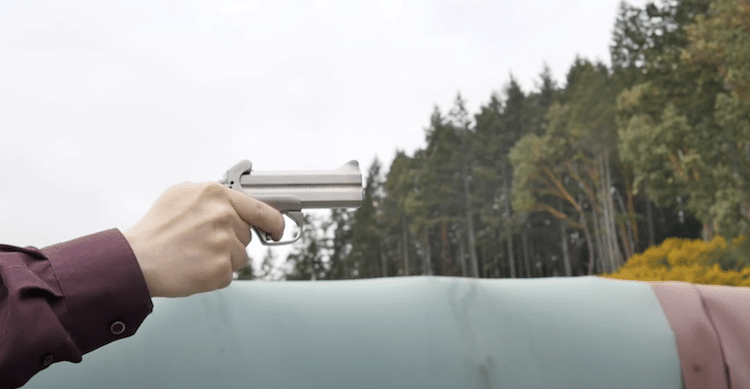
I did a little testing on the range and felt the recoil drop about 50% with the .38 Special vs the .357 Mag rounds. Changing from .38 Special to .38 S&W reduced that by another 10-20%.
I also wasn’t convinced that this short barrel would generate the required velocity to stop a foe, so I put it to the test.

Using my chronograph, I measured the .357 round and the .38 special rounds shot from the Mama Bear.
With the .357 Mag, I was constantly shooting from 800 to 1000+ FPS.
The .38 special was in the 700-900 FPS range, and with the .38 S&W, I was from 550 to 700 FPS.
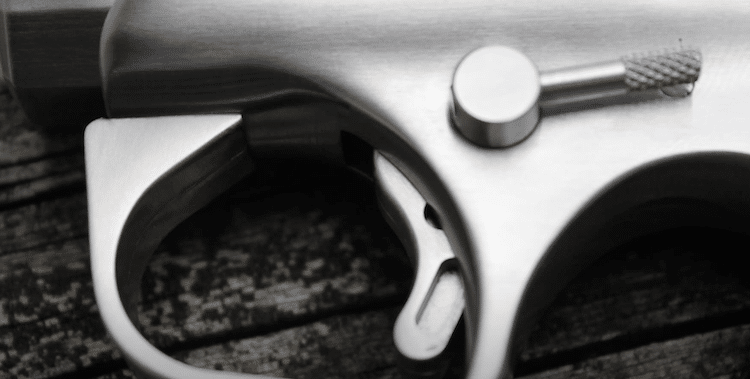
What this means to me is that the .38 S&W is great for target practice, but I would keep the .357 Mag in the chamber for actual carrying.
That means that you have a huge range to recoil and power to pick from, which is huge.
Side note…
The little lever on the slide releases the barrels, which flip up for loading and unloading. So, reloading is not fast.
The other drawbacks to this gun are:
- The exposed hammer
- Only 2 shots
- A very short grip
Bottom line.
The Mama Bear offers an extremely compact concealed gun that can shoot various rounds. This flexibility is a game changer.
This is the best pocket pistol for those who value concealment and small size over lots of rounds.
But rest assured…
If you get the bullet in the right place, it will get the job done.
Buying Guide For Pocket Pistols
Revolvers
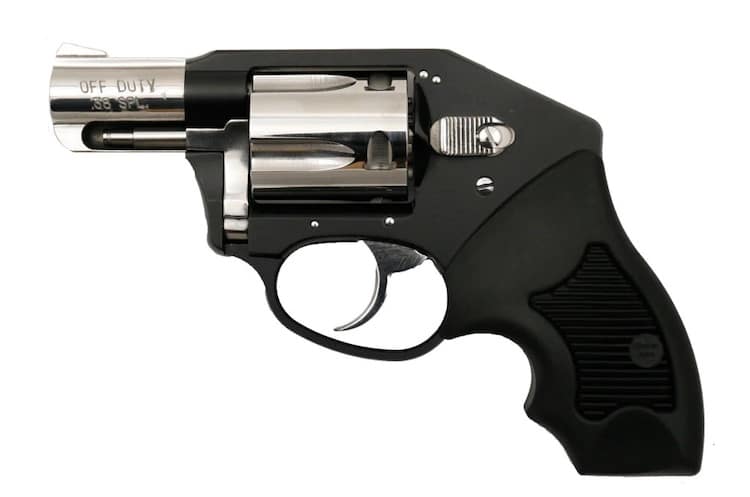
The best pocket pistols need to be hammerless, spurless, or have a shrouded hammer. The spur hammer usually associated with revolvers gets hung on EVERYTHING when you’re trying to pocket-carry.
In double action, the trigger pull is long, so you’ll want to practice at the range.
Advantages
- Dependable
- Break less commonly
Downsides
- You are usually limited to 5 shots
- Reloading is much slower than with an auto
- Larger profiles
Semi Auto
Finding a good semi-auto pocket pistol that actually fits in your pocket means moving into the sub-compact autos. Here, we have to make a distinction.
These semi-autos will fit in your pocket and will deliver a terminal message. If the shot isn’t immediately disabling, the attacker will certainly know something is wrong.

Advantages
- More ammo. Pocket autos give you up to 10 rounds in the mag.
- Less likely to print, IE, “show” on your clothes
- Typically easier trigger pull
Downsides
- More likely to jam
- Need to be cleaned more
- Hard to chamber the first round for weak grips
Mouse Guns

A derringer is a break-action over & under very short barrel gun. The barrel can be an inch. You can get them in rimfire and centerfire cartridges, all of which are anemic compared to the same round fired from a gun with a barrel of several inches.
Advantages
- Extremely small
- Lightweight
- No printing
Downsides
- One or two shots only
- Short range
- Less stopping power
- Higher recoil
Mouse Guns vs. Pocket Pistols
A mouse gun is a pocket pistol, called that because it has enough power to kill a mouse.
It might kill something bigger at point-blank range with the perfect shot placement. If you can afford it and can carry it, I’d suggest getting something bigger and stronger than a mouse gun.
What Is a Pocket Pistol?
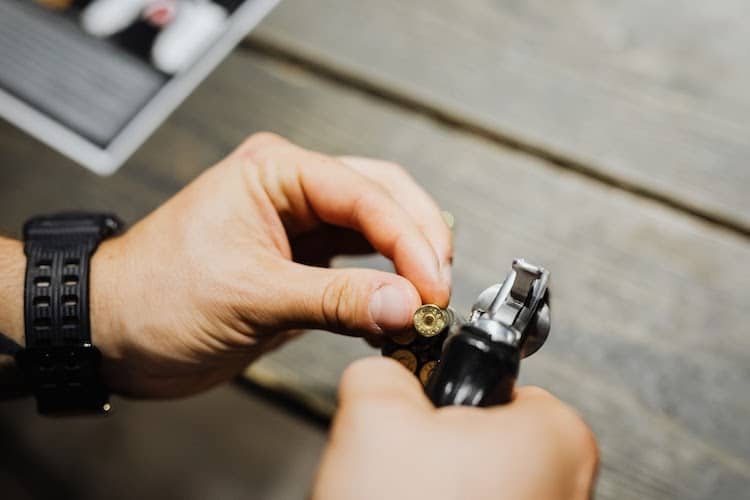
Literally, these pocket pistols fit in your pocket without showing anything to indicate you have a gun, pocket carry gun, or otherwise. Going forward, when I mention “pocket,” that will also include clutch purses.
These pocket pistols are small and can be sorted into categories of compact, subcompact, and mouse guns. Most have very low recoil and are only effective at self-defense range. (Reference: Best Pocket Pistols)
In general, stick to a .38 Special or a 9mm as the biggest pocket pistol caliber for concealed carry unless you enjoy sprained wrists.
I have several pocket pistols and I have shot the hand-manglers. I don’t own a pocket pistol bigger than a .38 Derringer.
Why Use a Pocket Pistol?
The best reason to use a pocket pistol is concealment. The best pocket pistols have a very low profile.
Done right, no one but you knows you have a gun on you.
Pocket Pistol Problems
Practice
The biggest problem with pocket pistol guns is common to most gun owners. People simply do not practice enough.
The best pocket pistol in the world won’t help you if you miss.
You need to practice shooting your gun. Burn a few boxes of shells a month. Learn to shoot from various uncomfortable positions.
Drawing the Gun
A second problem with a pocket pistol is learning how to draw it. Overcoming that simply means practice.
I carry my own pocket pistol in my front right pocket. I practice tugging the gun free of the pocket holster several times a day when no one is watching.

Pocket Lint
Your pocket picks up lint. This WILL get into your pocket pistol, make your gun jam, and stop your pocket pistol from firing. The solution is to clean your gun regularly.
Printing
Printing means the gun you carry is clearly visible as a gun through your pocket. This is another reason a holster is a great idea.
I’ve carried a leather pocket holster for more than 20 years. The leather adapted to me after a month. Note that Kydex will not shape itself to fit you.
Staying Safe
The best way to stay safe is to practice with your gun. Practice the draw. Practice dry firing. Practice live fire.
Learn how your gun rides in your pocket. If the gun spins or turns in your pocket, you need to get a holster that prevents this. Reaching into your pocket to pull your gun only to find it is upside down can be disastrous.
Pocket Carry Holster or Not

Get a holster, I really recommend it. It protects your gun. Pocket lint is going to happen, but a holster will limit this. You do need to clean the holster when you clean your gun.
Even the best pocket pistols in the world won’t fire if they’re full of lint.
If you carry something else in your pocket, like change, it’ll not make noise hitting the change. Also, the holster prevents anything else in your pocket from jamming the trigger.
Spend a bit more money and get a holster that hangs up in your pocket. When you draw your gun, the holster stays behind.
This is important!
If you draw your gun and the holster comes out too, you’ll spend precious time trying to free the gun.
My Thoughts on Concealed Carry Pistol
My favorite pocket pistol is a hammerless .38. It’s reliable, accurate at the distances I need to shoot, and will do the job for me. I’ve carried autos and derringers and will do so again.
The best pocket pistols are the ones you’ll actually use and carry.
Threat Level
I carry based on the expected threat level. The places I spend most of my time are very safe. Also, the places I spend most of my time have shotguns either within reach or a few steps away.
When I have to be in other places, I may change my EDC (every day carry). On a recent trip to the downtown region of a major international city, I stepped things up to an auto with IWB (inside the waistband) carry.
Recoil
Yes, there are other derringers that shoot bigger cartridges.
They are not on this list for one huge reason – recoil. Most people simply cannot handle the recoil from a derringer shooting anything bigger than a 9mm or a .38 special.
My .38 Derringer packs so much recoil the gun actually rotates in my grip.
Conflict Of Interest Disclosure
I did not accept any money from the manufacturer to feature their firearm on this review, nor did I accept any “free” items. All products listed on this article are there 100% due to the merits and my results testing them in the field. See the link in the footer for more info on how BarrettRifles.com makes money.
For any questions or concerns, drop a comment below or see our contact page.
More reading see: Best 1911 pistols and our write up on upgrades for your Glock pistol.
Top Pick: Ruger LCP Max 380 ACP Pistol

References
- Scott W. Wagner, Pocket Pistols: Then and Now. Retrieved from https://www.usconcealedcarry.com/blog/pocket-pistols-then-and-now/
Jeramy Smith is a writer, avid hunter, outdoor enthusiast, and firearms enthusiast. He grew up in both Virginia Beach, Virginia, and rural Michigan. He has soaked up as much information as possible about everything firearms related. He currently builds firearms and spends his days at the range and writing. He currently lives in rural central Michigan with his wife, 2 daughters, and 2 stepchildren.
📧 Reach me via email at: Jeramy@riflegearlab.com






